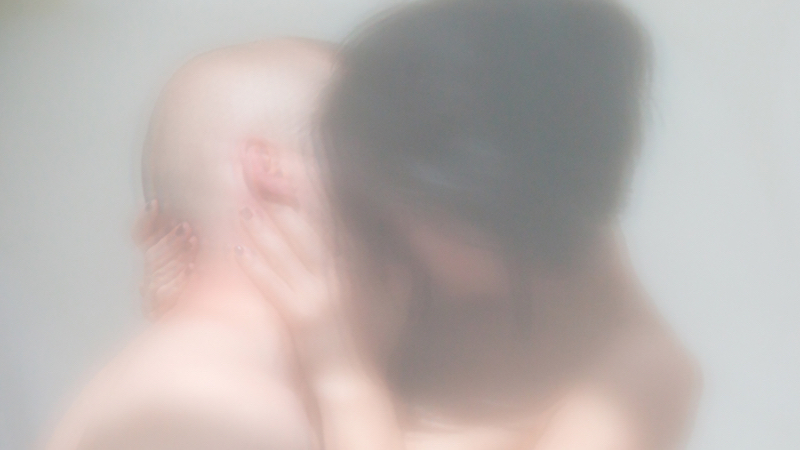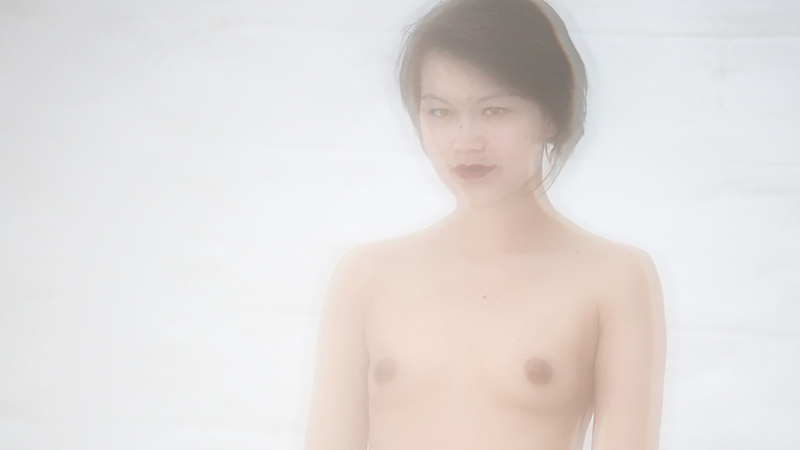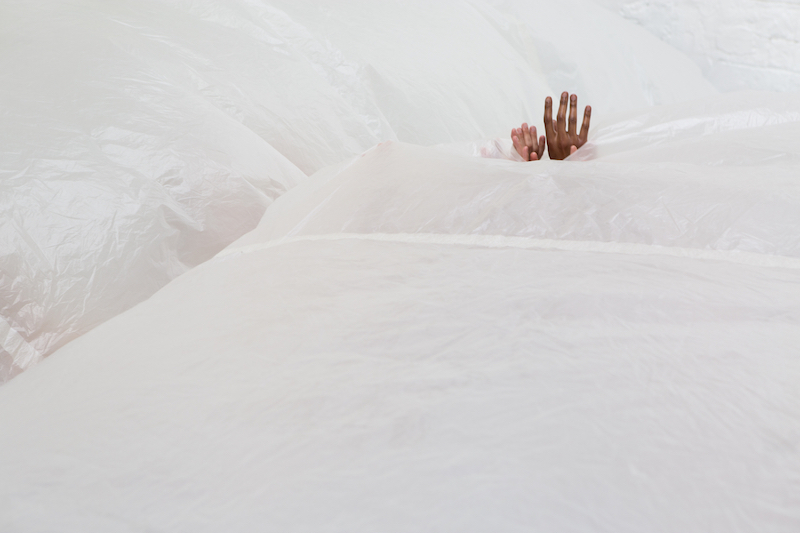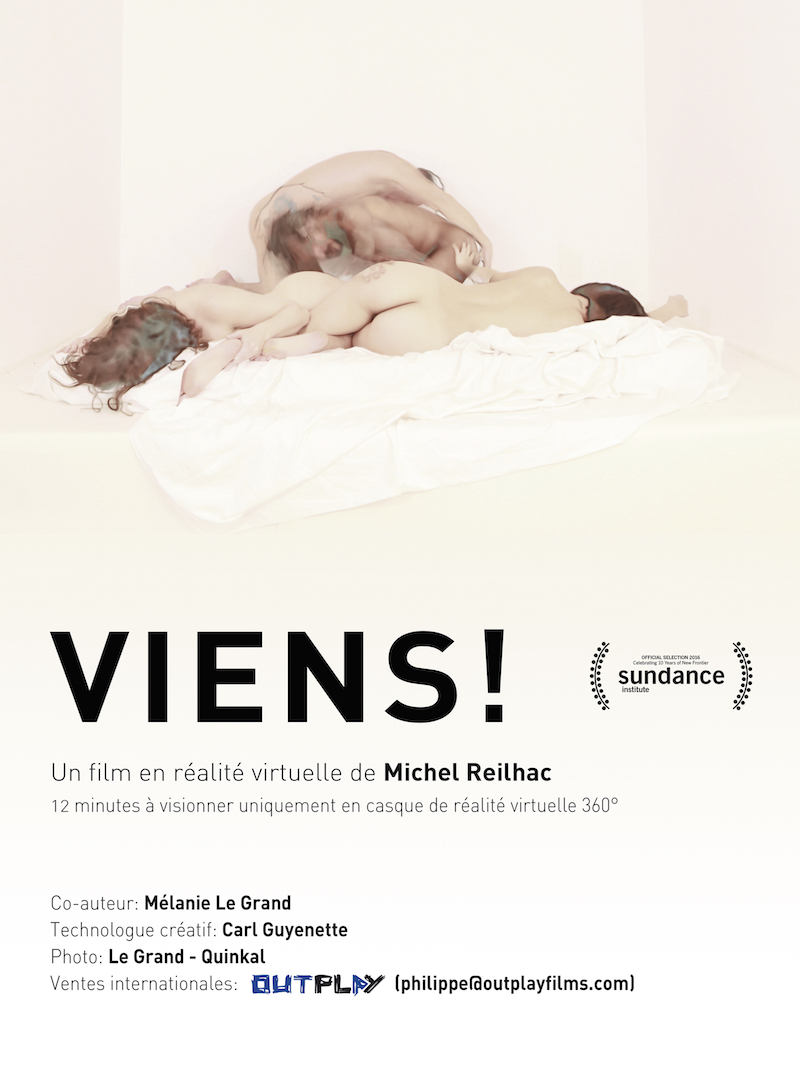For a brief week in October last year, visitors to SomoS Art House in Kreuzberg were treated to a twelve minute glimpse into a playful and sensual dreamscape free from inhibitions and the spatial parameters of reality. ‘Viens!’ (Come!) is the 2015 virtual reality film by Michel Reilhac, which debuted in the New Frontiers section of the 2016 Sundance Film Festival and featured in the recent Berlin exhibition ‘Custom Paradise’, in conjunction with the 2016 Berlin Porn Film Festival. Yet Reilhac’s film is not exactly pornography, nor a titillating simulation ride, but rather an immersive short film capturing a sensual interaction between eight people, and played out in 360 degrees around the viewer.

Michel Reilhac: ‘Viens!’, Film still, 2015 // Photography by Laurent Quinkal // Courtesy of the artist
Berlin gallery-goers were chaperoned through the work by two naked hosts (one of them, I found out later, was Reilhac himself) and invited to take their clothes off if they wished. The cushioned and sheer-curtained installation mimicked the white billowing sheets of the film set, and worked to ease viewers into the world of the film. It became quickly apparent that ‘Viens!’ is not about seamless technical flash or aiming for a sensational out-of-body experience. What viewers get is an uninhibited expression of human sexuality, and what you see is up to you. The title itself is an invitation. You can choose: are you a voyeur or a participant? With this film Reilhac takes VR in a direction away from the spectacular and the otherworldly and positions it as a tool for self-exploration. ‘Viens!’ asks us how we feel about intimacy, our bodies, and our sexualities, and how we interact with ourselves and others.
April Dell: ‘Viens!’ is very a intimate work. Is it the potential for an individual, almost personalised, viewing experience that attracted you to the medium?
Michel Reilhac: VR in essence is a new medium that allows for an unequalled level of sense of presence and intimacy for the viewer, in relationship with what he or she is watching in full immersiveness. The experiential nature of VR brings us much closer to our own feelings and reactions towards the story. Because I have always been fascinated by our own intimate relationship with our body and our sexuality, I wanted to experiment with the medium and explore how far I could go in sharing physical intimacy. That’s one reason.
Another reason is that I am truly intrigued by an essential challenge of VR, which is what I call “Presence Design”: since the viewer is present, at the heart of the story-world depicted, with full agency to choose what he or she wants to focus their attention upon, who will the viewer be in the story world? Who am I if I am present: am I a character in the story? Am I an abstract almighty presence? Do the other characters see me? Feel me? Can they interact with me? Should I interact with them? Or am I myself the viewer? It is a whole new field of story dynamics that these questions open: who is the viewer, since the viewer is here. With ‘Viens!’ I wanted to test one option: can the viewer be present as himself/ herself and yet be acknowledged by the characters? What kind of tension does that exchange between the real viewer and the fictional characters create?
In ‘Viens!’ the performers look at the camera repeatedly so that the viewer can feel that they are being invited into the scene by the characters. This does create a very personal connection during the viewing experience.

Michel Reilhac: ‘Viens!’, Film still, 2015 // Photography by Laurent Quinkal // Courtesy of the artist
AD: ‘Viens!’ is far from pornography, but it still teases the comfort boundaries of a general audience. What are you hoping to confront or promote with the sexual nature of the film?
MR: Beyond the exploration of the medium of VR itself, ‘Viens!’ is based on my intention to share my vision of sex as a tantric approach to spirituality. Shared intimacy is generally attached to the cultural notion of love as an exclusive and proprietary concept. Physical intimacy is generally acceptable only within the boundaries of the couple. But I believe that there are many different other kinds of ways to share and experience intimacy as a spiritual quest. Sexuality can take so many different shapes that exploring it openly is a never-ending experience. ‘Viens!’ is an attempt at opening boundaries to promote a tantric out-of-the-box approach to sexuality as a potential vehicle for one’s wholesome spiritual awakening.
AD: What excites you about VR’s new possibilities for storytelling? Watching ‘Viens!’ it felt to me that all the action was going on simultaneously around the room, rather than within a start-to-finish narrative structure.
MR: Yes, the idea was to immerse the viewer in a cocoon where things happen between the performers, very much as if thrown in the heart of a choreography. The feeling of being surrounded by men and women engaging in sensual physical interaction is designed to produce a sense of being totally immersed in the moment, as an eternal present. But that being said, there is definitely a time structure in the piece: first men and women seem to appear individually out of nowhere, as if generated by the moving matrix that covers the space.
They acknowledge each other.
They approach each other.
They explore each other.
They come together as one.
They blend into the matrix and dissolve into it, leaving space and time for another generation to appear.

Michel Reilhac: ‘Viens!’, Film still, 2015 // Photography by Laurent Quinkal // Courtesy of the artist

Michel Reilhac: ‘Viens!’, Film still, 2015 // Photography by Laurent Quinkal // Courtesy of the artist
AD: At SomoS Art House there was a performative aspect to the physical exhibition of the work. For you, is this link between the virtual world of the film and the physical space of the exhibition an important one to maintain?
MR: At Somos Art House, it was the first time I showed the piece as an installation. Because of the very physical nature of ‘Viens!’ and also because of its intention to promote another kind of relationship to our body, it became obvious that I had to go all the way and expand the VR experience into the real world. Getting naked in public is a mental threshold that is not easy to cross. But I thought that within the right protected context (the white tent that we built) it might be a poetic way of triggering people’s questioning of their own relationship to intimacy. VR does provide a major change in the accepted paradigm of how we have learned to represent the world. The VR experience is much more involving, much more real. Therefore, wanting to expand it into the physical realm is a natural extension of it. I am very intrigued and excited about the creative and experiential potential of telling stories that mix physical reality and VR in one and the same story-world. This is one direction I am currently exploring in the new work I am currently developing.
AD: Public accessibility and dissemination provide new challenges when making VR within an art context. Is this a drawback of the medium? How do you see this developing in the near future?
MR: At the moment, very few people own VR headsets. For this reason, it is still difficult to reach significant numbers of viewers. But if VR proves to be a success and more people see the need to get an HMD, little by little VR interfaces are going to become a new norm. If social networks like Facebook are going to start rolling out more services in VR, people are going to get used to this new way of interacting with each other from a distance. When this starts happening, dissemination of work will not be a problem any longer.
But I do fear, as many people do, the disconnection effect that VR may have for us with real interaction. My hope is that we will quickly learn how VR can be a fantastic way to share experiences that would not be possible in the real world, but not as a replacement for all the things we can do physically. A bit like we have learned how to use Skype as an ersatz of presence when being far away.
And we do not know yet how the collective experience of being immersed together at the same time in one same VR experience will feel. There will definitely be a new iteration of Second Life in VR. That is the ultimate goal of the people at Oculus and Facebook, for example. What will that mean in terms of sharing art, stories, experiences?
AD: As an artist, is there pressure to keep up and to stay relevant working within the high-tech entertainment realm?
MR: The high tech nature of VR is definitely a pressure, also because the field is evolving so quickly that it is hard to keep up with all the new possibilities. But there is also a lot of hype and fluff. I tend to try and focus on the essence of the stories I want to tell. Story remains the heart and reason of why we should use VR. A bad story is not going to be transformed into a good one magically just because it is told in VR.
Beyond the technical competition, there are significant challenges in the new dynamics that need to be invented around 360° storytelling: presence design, simultaneous narrative threads, spatial writing, intertwined realities, interactive impacts on story development, subjective POV, body representation and avatar inclusion, spherical editing. There are so many structural narrative elements that are completely new within the VR language, that I tend to focus on these.


























